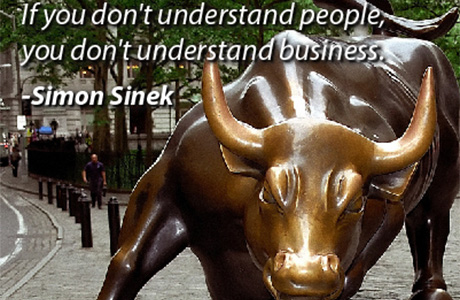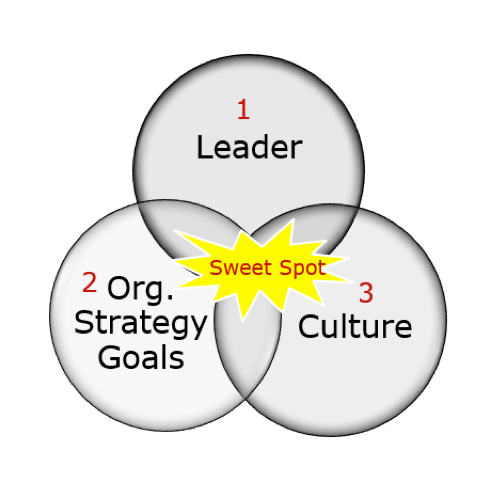The Sweet Spot of Success
Editor’s Note: This was originally posted on CultureUniversity.com

A Sweet Spot exists at the intersection of three areas of context for any business transformation (Change). It is critical for leaders to get context clarity on these areas to make the difference between a resounding successful change and a crashing failure.
The Sweet Spot:
- Leadership Context – What are the leader’s skills, strengths and experiences in leading change? What is the leader’s commitment to the change?
- Organizational Strategy (Change) Context – What must change? Why is change needed? As a result of the change, what does success look like?
- Organizational Culture Context – What are the underlying beliefs and behaviors that shape the performance and potential of the organization?
Sweet Spot = the winning formula for leading change
1. Leadership Context
For a leader to be successful implementing change, the leader must be aware of his or her own ability to lead the change within the context of the organization. Prior success in another organization does not mean automatic success in the present organization. There are countless examples of successful leaders that have been swallowed up and spit out by the culture of a new organization when they have attempted to implement new change.
Leading change well is an essential capability for all leaders. Change leadership attributes include:
- Demonstrate Integrity – results and relationships are the twin markers of this attribute. As leaders are achieving results are they maintaining great relationships or leaving a wake of dead bodies behind as they accomplish great things? Results that violate people lead to long term failure and more difficult change in the future.
- Model Change – in order to lead there must be followers. In order to have followers a leader must build trust, communicate effectively, inspire others to support the change and be an exemplar for the change. Being an exemplar of change leads back to integrity. When words and actions don’t match (integrity) the leader will lose trust. Without trust the change takes longer, costs more and makes a damaging imprint in the cultural memory of the organization. Do leaders do what they say and say what they mean?
- Manage Complexity – we are drowning in information, activities and stuff. The best leaders make meaning out of the madness and simplify whenever possible. The business methodology of the same name addresses the activities around the four pillars of strategy, transparency, total value chain and sustainability. All that translates into focusing on what really matters and eliminating the rest. Is your leader simplifying or making things more complex?
An assessment against these leadership attributes will reveal a leaders strengths and opportunities for improvements. Change leadership is simple yet difficult. Most leaders know what to do, it’s the doing that’s hard. Close the “know | do gap” in order to maximize change leadership.
2. Strategy or Change Context
In assessing the context of a change a few questions must be considered:
- What are the change impacts on people?
- What does success look like? What is the strategy, result or goal that must be achieved? Can the change be described in an inspiring manner with absolute clarity?
Understanding the Change Environment
Changes don’t occur in a vacuum. An organization has a maximum capacity to absorb change. It is possible for people within an organization to become saturated with change. When change saturation occurs, dysfunction begins and the change will slow down or ultimately fail to achieve the intended benefits.
An assessment of the cumulative impact of changes within an organization will enable the leadership team to make informed decisions about how to implement a portfolio of changes. Changes can be canceled, staged, extended or altered in some other way to reduce the impact to stakeholders at a given point in time. What is important is that changes are managed in a way that enables successful implementation while still successfully serving customers.
Understand the Change:
Before a leader begins any change, he or she must start with an understanding of the change by answering the following questions:
- What is the change? This isn’t the action that you are taking, change is the difference between the ways things are today and how you intend them to be in the future.
- Why does the change matter? Why is the change happening?
- Who is being impacted, directly or indirectly by the change?
- How significant is the change to the people being impacted? This is from their point of view not the leader’s point of view. It’s easy to assume the change is insignificant when it’s observed from a higher vantage point.
- When is the change taking place? While one change may seem rather minor, the impact is compounded when change is happening in the midst of multiple changes. There are limited resources for adopting changes. Be careful how you use up your people’s change capacity.
3. Organizational Culture Context
Culture is the shared patterns of belief and behavior that create an outcome. Collective outcomes are known as performance or productivity. When it’s time to change the outcome, it’s time to change the culture.
These shared patterns of beliefs and behavior are essential to inspiring change and reducing resistance. Before starting down the path of change, leaders must understand the cultural context. It is akin to knowing how much you weigh prior to beginning a weight loss program. If you don’t know your starting weight, you won’t know what to change or how much to change to get your result. It’s the same for culture, measure before you begin.
Three Simple Steps to Success:
- Assess – where you are to get an accurate understanding of your current reality. An assessment will reveal your organizational strengths and opportunities.
- Define – your future reality; what strengths you will build on and what needs redefined or restructured to achieve the future reality. This may require culture change to incorporate new beliefs and behaviors.
- Align – what you do and what you say. To achieve culture change there are a series of alignment steps that support employees as they build on strength and transition to new beliefs and behaviors. Maintaining this alignment is one of the most challenging aspects of culture change.
The Sweet Spot of Success – Change Leadership:
Once there is a clear understanding of the leadership context, change context, and culture context, here are some considerations for successfully leading through the change:
- Uncertainty drains productivity – when people are uncertain about the future or the change, it significantly impacts productivity. While leaders may not have all the answers, it’s important to share progress and create some certainty.
- Data doesn’t have meaning until you make it – too many change messages contain lots of data that gets lost on the recipient. Without context, content is confusing. So take the time to clearly and effectively share the story behind the data and make meaning.
- Begin with the reader / listener in mind – when sharing the change with others, remember who they are and what matters to them. Speak in their language not yours. “If you talk to a man in a language he understands, that goes to his head. If you talk to him in his language that goes to his heart” (Nelson Mandela.) The language of the heart is the language of change.
Leadership is the magic ingredient for successful change. The best processes, methods and tools cannot overcome a lack of great leadership. So take the time to understand the changes you intend and the environment you intend to implement them in and then use these techniques to successfully achieve results.
What other changes in your organization are standing in the way of the changes that matter? How ready and aligned is your culture to adopt the change? Please comment below & share this post.

